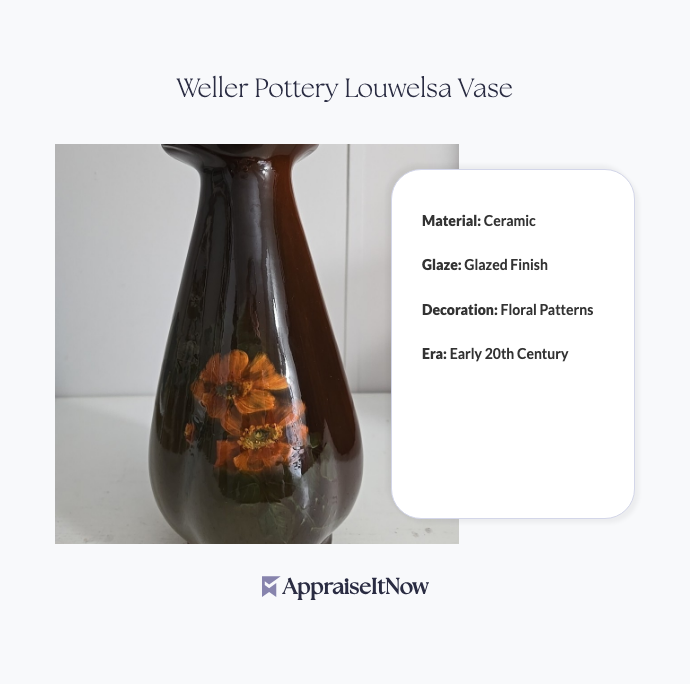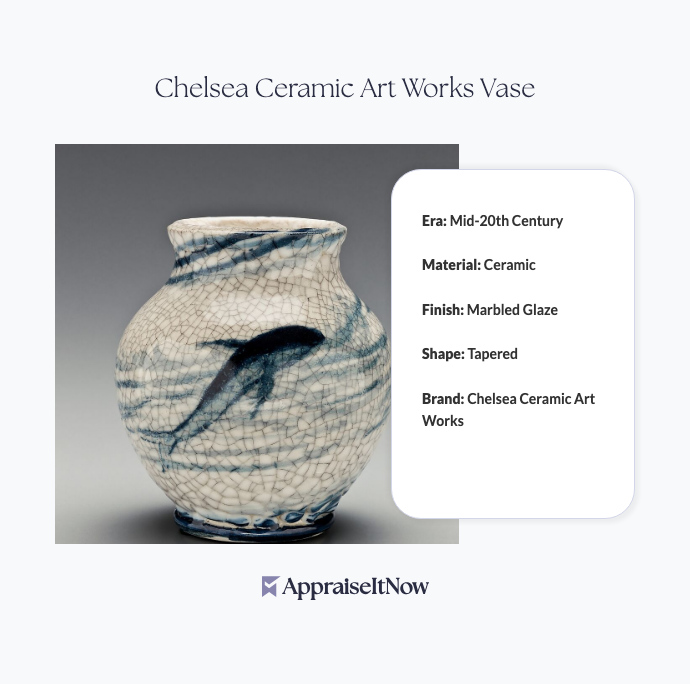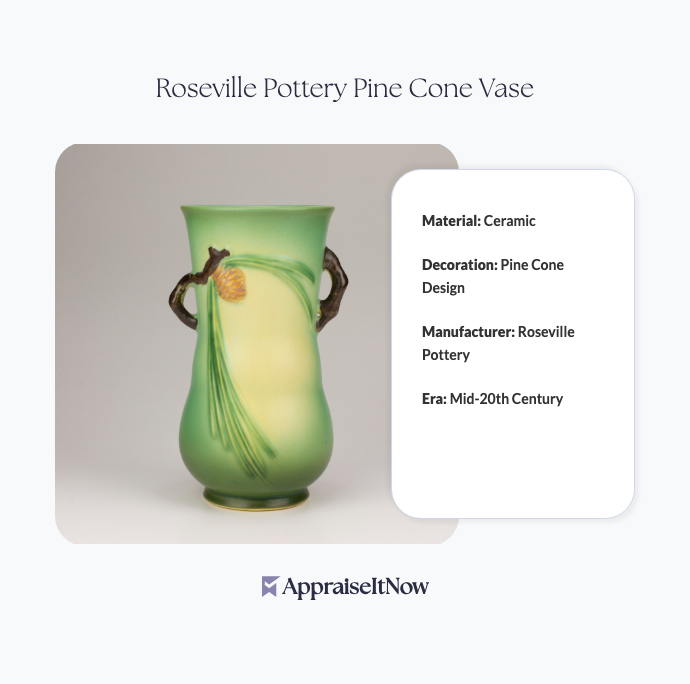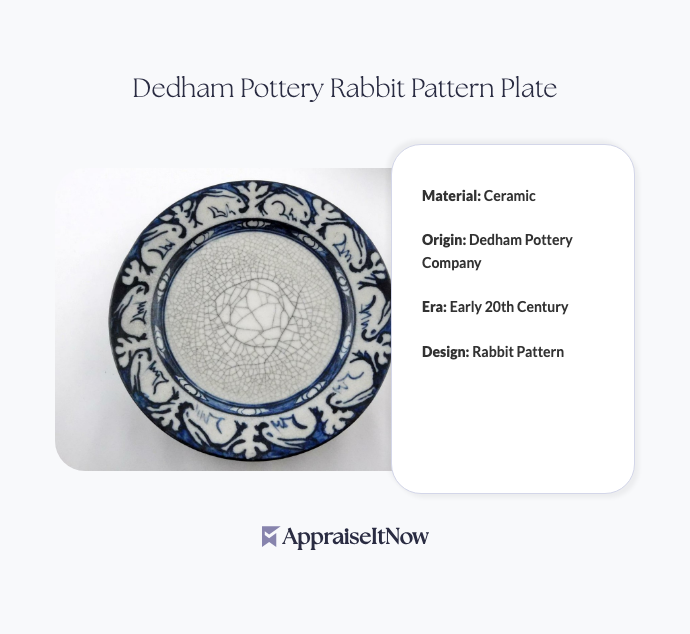<h1>How to Get Your Weller Pottery Louwelsa Vase Appraised</h1>
<p>The Weller Pottery Louwelsa Vase represents a treasured piece of American ceramic artistry, commanding market values between <strong>$1,000 and $2,000</strong> for quality examples. Whether you've inherited this distinctive glazed vase, are considering a purchase, or need accurate documentation for insurance or estate purposes, understanding the appraisal process ensures you receive a reliable valuation that reflects its true worth.</p>
<h2>Why Your Louwelsa Vase Warrants Professional Appraisal</h2>
<p>The Weller Pottery Louwelsa line stands among the most sought-after American art pottery, prized by collectors for its exceptional craftsmanship, artistic significance, and historical value. These vases showcase distinctive hand-painted floral patterns and a characteristic glossy glaze that defined the Louwelsa aesthetic from its introduction in <strong>1906</strong> through the company's peak production years. Unlike mass-produced ceramics, each Louwelsa piece represents individual artistry, making professional appraisal essential for establishing accurate value and authenticity.</p>
<p>When was Weller Louwelsa made? The line's production spanned several decades, with pieces from the early 1900s commanding particular attention from serious <a href="/blog/appraisers-for-collectibles">collectibles appraisers</a>. The quality of execution, artistic merit, and historical provenance all factor into determining whether your vase falls toward the lower or upper end of the $1,000-$2,000 range—or potentially beyond it.</p>
<div class="callout tip"><p><strong>Valuation Insight</strong></p>
<p>Rarity, condition, and documented provenance can push exceptional Weller Louwelsa vases well above the standard market range, making professional assessment crucial.</p></div>
<h2>Key Features Appraisers Evaluate</h2>
<p>When a qualified appraiser examines your Weller Pottery Louwelsa Vase, they assess multiple dimensions that directly impact value. The distinctive Louwelsa glaze—a hallmark of the line—requires careful examination to confirm authenticity and determine condition. This hand-applied finish characterizes the company's renowned craftsmanship, and its preservation significantly affects appraisal results.</p>
<p>The intricate floral patterns that define Louwelsa pieces are typically hand-painted, making each example unique. Appraisers evaluate the detail work, color vibrancy, and artistic quality of these designs. Your vase's elegant silhouette and proportions also factor into assessment, as superior aesthetic design enhances desirability among collectors of <a href="/types/antique-artwork">antique artwork</a> and fine ceramics.</p>
<p>High-quality clay composition, achieved through Weller's commitment to material excellence, contributes to the vase's durability and value. When examining your piece, appraisers look for signs of superior construction, including proper firing, structural integrity, and the absence of defects that would diminish both functionality and aesthetic appeal.</p>
<h2>Understanding Weller Pottery's Historical Context</h2>
<p>Is Weller Pottery always marked? While most legitimate Weller pieces bear identifying marks, the style and location of markings vary across production periods and individual lines. Your Louwelsa vase should display clear identification, typically found on the base, confirming manufacture by <strong>Weller Pottery Company</strong>, based in Zanesville, Ohio. Professional appraisers verify these markings as part of their authentication process, examining size, depth, and consistency with documented examples from comparable periods.</p>
<p>Weller's reputation for producing American art pottery of distinction stems from the company's commitment to both artistic design and technical excellence. The company's influence on the broader art pottery movement, combined with the limited availability of quality Louwelsa examples today, positions your vase as a valuable collectible. Understanding this historical significance helps contextualize its market position among <a href="/types/antiques">antiques</a> and period ceramics.</p>
<p>When did Weller Pottery go out of business? The company's closure adds to the collectibility of existing pieces. While Weller operated for decades, producing numerous lines, the discontinuation of production means no new Louwelsa vases will enter the market, ensuring that existing examples retain and appreciate in value.</p>
<h2>Condition Assessment and Value Impact</h2>
<p>The condition of your Weller Pottery Louwelsa Vase directly determines its position within the $1,000-$2,000 valuation range. Professional appraisers conduct thorough condition assessments examining surface integrity, glaze quality, and structural soundness. Minor crazing—fine lines in the glaze—is typical and expected in antique ceramics, but more significant damage substantially reduces value. Chips, cracks, or repairs, whether visible or professionally concealed, all factor into the appraiser's final assessment.</p>
<p>The vase's color saturation and glaze finish are evaluated for original appearance versus aging or deterioration. Original patina is often valued more highly than recent refinishing, as it documents authenticity and historical use. An appraiser may use specialized lighting to detect previous repairs or alterations invisible to casual inspection. This detailed examination ensures your appraisal accurately reflects current market expectations for condition at the time of valuation.</p>
<div class="callout note"><p><strong>Condition Matters</strong></p>
<p>A pristine Louwelsa vase with vibrant colors and flawless glaze can command the upper end of market values, while pieces with notable repairs may settle toward lower estimates.</p></div>
<h2>Rarity and Demand Factors</h2>
<p>Where is Weller Pottery made? Understanding production history helps appraisers contextualize rarity within the broader Louwelsa line. Certain size variations, particularly rare color combinations, or examples with exceptional artistic execution become more valuable as demand from serious collectors continues. The influence of rarity and demand significantly affects pricing, particularly for pieces that represent scarce variations within an already limited production run.</p>
<p>Weller Pottery enthusiasts actively seek examples that display superior artistic merit or unusual characteristics. Your vase's specific design, whether it represents a common pattern or a distinctive variant, influences its standing in today's market. Professional appraisers maintain knowledge of recent sales, collector preferences, and emerging market trends affecting <a href="/types/memorabilia-and-collectibles">memorabilia and collectibles</a> valuations, allowing them to position your piece accurately within current market dynamics.</p>
<p>Is Weller Pottery valuable today? Absolutely. The consistent appreciation of quality Louwelsa pieces, combined with growing collector interest in American art pottery, supports strong demand. This market strength justifies investment in professional appraisal services that document value for insurance, estate planning, or potential sale purposes.</p>
<h2>The Role of Documentation and Provenance</h2>
<p>Your Weller Pottery Louwelsa Vase's provenance—its ownership history and documented background—influences appraiser assessment. Pieces with clear provenance linking them to notable collections or documented exhibitions may carry additional value premiums. While not all vases come with complete ownership records, any documentation you possess should be compiled and presented to your appraiser.</p>
<p>Professional appraisers specializing in <a href="/blog/appraisals-for-fine-porcelain-and-ceramics-valuing-delicate-artistry">fine porcelain and ceramics</a> understand how to evaluate and integrate provenance information into their final valuations. Even if your vase lacks extensive documentation, thorough examination of marks, construction techniques, and stylistic elements allows qualified appraisers to confirm authenticity and establish fair market value based on comparable sales and collector demand.</p>
<h2>Finding a Qualified Appraiser for Your Louwelsa Vase</h2>
<p>Selecting the right appraiser ensures you receive an accurate, professional valuation. Look for appraisers with specific experience in American art pottery and antique ceramics, as this expertise directly impacts assessment quality. Credentials matter—seek appraisers with professional certifications (AAA, ISA, ASA, CAGA, AMEA) and demonstrated knowledge of Weller Pottery and comparable lines within the broader art pottery market.</p>
<p><strong>AppraiseItNow</strong> connects you with credentialed appraisers across the U.S. who specialize in <a href="/blog/appraising-antiques-unveiling-the-hidden-treasures-in-your-collection">antique appraisals</a> and collectible ceramics. Our platform streamlines the appraisal process—you submit photographs, descriptions, and relevant documentation online, then receive USPAP-compliant valuations from certified experts. This efficient approach provides professional-grade assessments suitable for insurance purposes, estate planning, or sale preparation.</p>
<div class="callout tip"><p><strong>Appraiser Selection</strong></p>
<p>Request sample reports and verify credentials before committing to an appraisal. Quality appraisers provide detailed documentation explaining their valuation methodology.</p></div>
<h2>Insurance and Documentation Value</h2>
<p>Professional appraisals serve essential practical purposes beyond establishing market value. Insurance companies typically require certified appraisals for coverage of high-value items, and your Louwelsa vase almost certainly qualifies. A detailed appraisal report provides documentation of condition, value, and identifying features that supports insurance claims should damage or loss occur.</p>
<p>Estate planning and wealth management professionals similarly rely on professional appraisals to establish asset values for tax purposes, distribution decisions, and overall estate documentation. Whether you're protecting your investment through proper insurance or preparing for estate transfer, a certified appraisal creates an official record reflecting your vase's worth at a specific point in time, providing documentation that stands up to professional scrutiny and legal requirements.</p>
<h2>Market Trends in American Art Pottery</h2>
<p>The broader market for American art pottery, including Weller's various lines, has demonstrated steady appreciation over the past two decades. Collector interest in early-to-mid-twentieth-century American ceramics continues growing, driven by appreciation for handcrafted artistry and historical significance. This sustained demand supports the $1,000-$2,000 valuation range for quality Louwelsa examples while creating potential for values to shift as market conditions evolve.</p>
<p>Professional appraisers maintain awareness of these trends, allowing them to contextualize your vase's value within current market conditions. Why is Weller so hard to get? The combination of limited original production, natural losses through breakage over decades, and increasing collector competition creates scarcity that supports valuations. This dynamic underscores the importance of regular appraisal updates, particularly if you plan to sell or need accurate insurance documentation several years after initial assessment.</p>
<div class="callout note"><p><strong>Key Takeaway</strong></p>
<p>A certified appraisal of your Weller Pottery Louwelsa Vase provides essential documentation for insurance protection, estate planning, and confident decision-making regarding purchase or sale. Professional expertise ensures your vase's true value—between $1,000 and $2,000 for quality examples—is accurately documented and supported by credentialed assessment of its condition, rarity, and market position.</p></div>







.avif)







